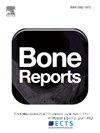Am I big boned? Bone length scaled reference data for HRpQCT measures of the radial and tibial diaphysis in White adults
Abstract
Cross-sectional size of a long bone shaft influences its mechanical properties. We recently used high-resolution peripheral quantitative computed tomography (HRpQCT) to create reference data for size measures of the radial and tibial diaphyses. However, data did not take into account the impact of bone length. Human bone exhibits relatively isometric allometry whereby cross-sectional area increases proportionally with bone length. The consequence is that taller than average individuals will generally have larger z-scores for bone size outcomes when length is not considered. The goal of the current work was to develop a means of determining whether an individual's cross-sectional bone size is suitable for their bone length. HRpQCT scans performed at 30 % of bone length proximal from the distal end of the radius and tibia were acquired from 1034 White females (age = 18.0 to 85.3 y) and 392 White males (age = 18.4 to 83.6 y). Positive relationships were confirmed between bone length and cross-sectional areas and estimated mechanical properties. Scaling factors were calculated and used to scale HRpQCT outcomes to bone length. Centile curves were generated for both raw and bone length scaled HRpQCT data using the LMS approach. Excel-based calculators are provided to facilitate calculation of z-scores for both raw and bone length scaled HRpQCT outcomes. The raw z-scores indicate the magnitude that an individual's HRpQCT outcomes differ relative to expected sex- and age-specific values, with the scaled z-scores also considering bone length. The latter enables it to be determined whether an individual or population of interest has normal sized bones for their length, which may have implications for injury risk. In addition to providing a means of expressing HRpQCT bone size outcomes relative to bone length, the current study also provides centile curves for outcomes previously without reference data, including tissue mineral density and moments of inertia.

 求助内容:
求助内容: 应助结果提醒方式:
应助结果提醒方式:


